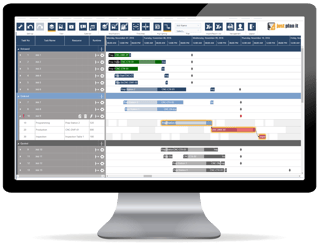Menu

For many job shops, the RFQ (request for quote) is a crucial building block in winning new clients and building long-term customer partnerships as Frank Russo, CEO of fabricating.com rightfully states. Amongst other factors, price and time are obviously the two prevailing criteria that determine the success of a RFQ submission in terms of winning the deal. This blog post deals with the time dimension "time", and provides job shops with strategies of how to achieve a faster RFQ - with "faster" pointing in two directions: (a) how to complete a RFQ faster and (b) how to make more confident commitments for a faster shipment of the requested scope of delivery.
We all have heard the saying "time is money". For a couple of reasons, this saying should be more than a mantra for job shops (honestly, it should be the mantra).
 If you receive a request for proposal and if you are able to provide an answer faster than your competitors, this says a lot about you:
If you receive a request for proposal and if you are able to provide an answer faster than your competitors, this says a lot about you:
Overall, a fast and reliable response to an RFQ helps you build the perception of running an effective shop.
So, now that it is clear that a faster RFQ fulfillment will be truly beneficial for you (a must!), you might wonder how to actually get this done. Well, my answer to this is: with a proper job shop scheduling software.
Here is why: One of the crucial tasks of getting the RFQ together is to determine the delivery time that you can commit to for the requested scope of supply. This calculation has to take into account your resource availability, your capacity utilization through other jobs, priorities, time-related restrictions such as delivery dates of your suppliers as well as the impacts that squeezing this job in will have on other jobs (i.e. giving it a comparably high priority). Solving this puzzle can become quite difficult and cumbersome, especially doing it in your head, on a whiteboard or even with a homegrown Excel-based scheduling system.
Guess what: Determining the expected delivery time of a new order, while taking into account all of the above considerations is exactly what a proper scheduling system should do.
As job shop, you typically contribute to a much broader supply chain. The fact that a large manufacturing or engineering company tasked you with providing a piece for this supply chain tells you that you have a certain skillset that they don't. Instead of building this expertise by themselves (I assume they would have the money and means to do so) they rely on you to provide the requested piece in time, quality and budget.
Hence, you become a crucial element in that larger supply chain; one that your customer can control less easy than its own resources. In addition, the leverage you have on that entire supply chain is much higher than the value of your delivery. You have become the critical cog in the customer's wheel of revenue. From your customers' standpoint, the (financial) risk of having you as a part of their supply chain will become smaller the earlier they receive your delivery (because from then on they will have everything under their own control again). This means, the faster you are able to deliver, and the more reliable and firm your delivery time commitment is, the higher the chancesare that you will get the order.
What do you think you can do to potentially decrease your delivery times and to commit to a tight deliver timeframe with higher confidence? My answer should not surprise you.
Utilize a proper job shop scheduling software.
 Here is why: A shop scheduling system typically includes some smart scheduling heuristics that on the one hand make sure that resources don't get overbooked and on the other hand ensures that your jobs and their tasks are allocated to the available resources in an efficient manner. This makes sure that the timeframe to complete the job should be rather short as idle times are reduced as far as possible. Hence, such a scheduling heuristic will provide you with the confidence of having an achievable production schedule. An intelligent and visual schedule typically should be capable of providing some additional insights about the elasticity of the schedule including information on the latest possible start date of a job to meet the requested delivery date or on the buffer time between the requested delivery data and the expected completion date if you squeeze in other jobs that might come in on short-notice. This kind of schedule elasticity intelligence lets you understand cause and effect in your schedule way better and hence increases the confidence in the decision of the ambitious delivery time calculated by the software.
Here is why: A shop scheduling system typically includes some smart scheduling heuristics that on the one hand make sure that resources don't get overbooked and on the other hand ensures that your jobs and their tasks are allocated to the available resources in an efficient manner. This makes sure that the timeframe to complete the job should be rather short as idle times are reduced as far as possible. Hence, such a scheduling heuristic will provide you with the confidence of having an achievable production schedule. An intelligent and visual schedule typically should be capable of providing some additional insights about the elasticity of the schedule including information on the latest possible start date of a job to meet the requested delivery date or on the buffer time between the requested delivery data and the expected completion date if you squeeze in other jobs that might come in on short-notice. This kind of schedule elasticity intelligence lets you understand cause and effect in your schedule way better and hence increases the confidence in the decision of the ambitious delivery time calculated by the software.
A scheduling system which is tailored towards the characteristics of a job shop, when used correctly, should prove to be very useful when it comes to improving the factor "time" in your request-for-quote submissions. This is especially true if this system is explicitly built to facilitate the use case of keeping delivery times under control.
My offer for you: Find out for yourself by trying out our just plan it software and seeing how it copes with the above ideas. You are cordially welcome to sign up for a free 30 days trial and give it a try. We do not ask you for your credit card when you test the software. But we are happy to give you free-of-charge support and consulting during the trial if you reach out and ask. Let's go!
just plan it is a production scheduling software plus scheduling tools & best practices to help high-mix low-volume make-to-order manufacturers gain transparency and control over their shop operations. The software plus its methodology is used by thousands of people around the globe. They consistently achieve improved on-time deliveries, shorter lead times, and better utilization of their resources.
As just plan it is not just software, but a lot of processes and best practices, we recommend that you start with an exploratory meeting. If we agree that there is a fit between your requirements and our approach, we'll build a prototype for you.
Hence, it all starts with a meeting. Book that meeting now.
These Stories on Machine shop scheduling
Made with by BOYUM IT SOLUTIONS GmbH (Copyright © 2024) Read our Privacy Policy & Terms of Service
Comments (2)